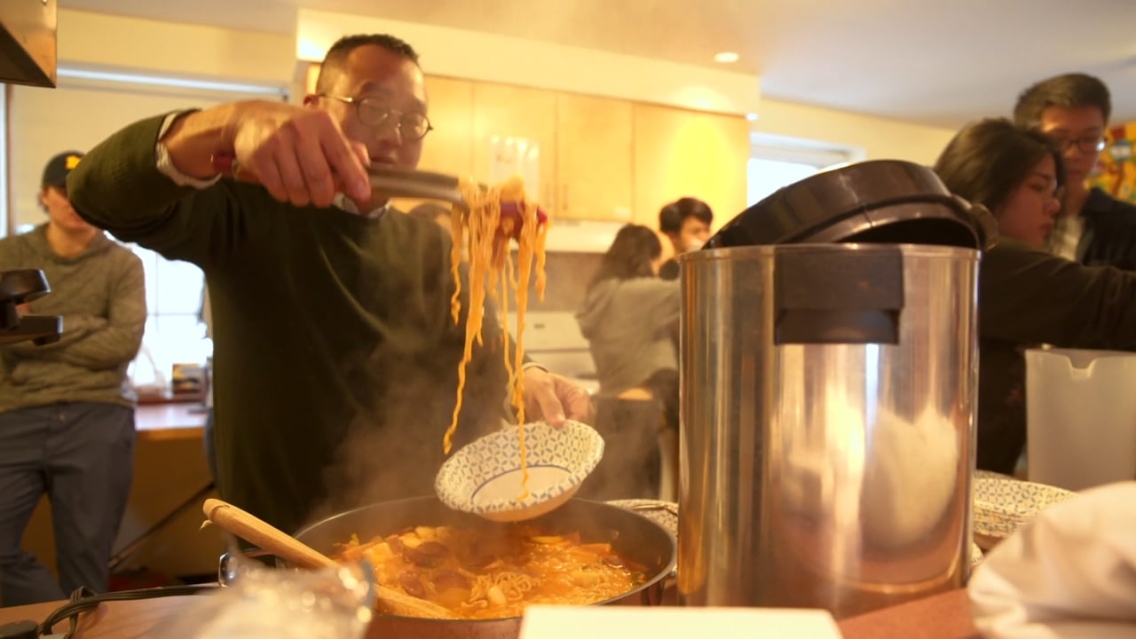J-Term Scenes: Asian American Food Studies (Video)
MIDDLEBURY, Vt. – There is no such thing as food authenticity. That’s a point Rachael Miyung Joo made abundantly clear during her new winter-term course called Asian American Food Studies.
“Food culture, like any other culture, is changing constantly, and it’s mixing or improving—or maybe not improving—but there’s no such thing as an authentic food,” says the associate professor of American studies. In a course blending the fields of Asian American studies and food studies, Joo has found an ideal way to study cultural history.
“So many questions that are in Asian American studies are about identity and community,” said Joo. “And belonging and race are accessed through metaphors that use food or rely on food or differences in food ways, so I think it’s a really great way to connect these two fields.”
One of the first things Joo had her students do at the start of the term was to eat something and try to describe it, and to go beyond basic ways of talking about food. She brought some Asian snacks to class and had the students describe what they were tasting, how they experienced the foods, and what their senses told them.
“The food becomes the entry point into thinking about these broader issues,” said Joo. “And since it’s a writing class, I really wanted to get the students thinking about evocative ways to describe food.”
As snow swirled outside Forest Hall on a recent weeknight, Joo’s class gathered in the kitchen of the Anderson Freeman Resource Center for a firsthand taste of cross-cultural food history. Robert Ku, author of Dubious Gastronomy: Eating Asian in the USA and a pioneer in the field of Asian American food studies, was visiting the class and cooking for them. He and Joo had decided to make budae jjigae—a dish whose ingredients some might consider “dubious”—to correspond with class discussions on authenticity and ideas around foreign food.
Stirring a large steaming pan on the stove, Ku added packaged Ramen noodles, Spam, American cheese, Vienna sausages, baked beans, onions, scallions, garlic, kimchi, and yangyum (sauce) to create a spicy, savory dish.
The name budae jjigae roughly translates to “Army base stew.” Joo said the stew was the result of relationships that formed between impoverished Koreans, whose country was devastated by the Korean War, and the 50,000 American military personnel who were permanently stationed in the country. The canned goods sent for American consumption were prized by the Koreans for their high calories, protein, and long shelf life.
“While our attitudes toward those foods have changed significantly, the foods still have some cultural power in the Korean context,” said Joo. “It’s associated with nostalgia for some, but also this campy idea of how this food, which was once a testament to the impoverishment of Korean people, is now a food that we can embrace as our own. And we’re beyond this sense of dependence, but we can still acknowledge that the food is tasty.”
Some of the students were initially wary of the concoction. “I was skeptical about it at first just because it had spam, Vienna sausages, American cheese all thrown into one pot,” said Chase Royer ’21, a neuroscience major from Blackshear, Georgia. “But it was actually a really good flavor. I wouldn’t eat it all the time, but it was interesting to try.”
The class prompted Cathleen Huang ’21 to want to learn more about her own personal food history. “I think I am going to watch how my mom cooks more and more at home now and try to learn about my own food,” said the molecular biology, biochemistry, and political science major from Arcadia, California.
“It’s a family bonding experience,” Huang, who identifies as Asian American, said. “It’s also a way where culture is passed down. These are the foods we ate back in my parents’ hometown, Fuzhou, and this is the food you are eating now in America. I feel like it’s culture and family time.”
Joo hopes her students will also leave the J-term class with a more critical eye toward how forces in the food industry influence the choices they make. She’d like them to navigate the food system with “more awareness about what goes into their bodies and how what they consume on a daily basis is really a product of history and of politics and social relationships.”


